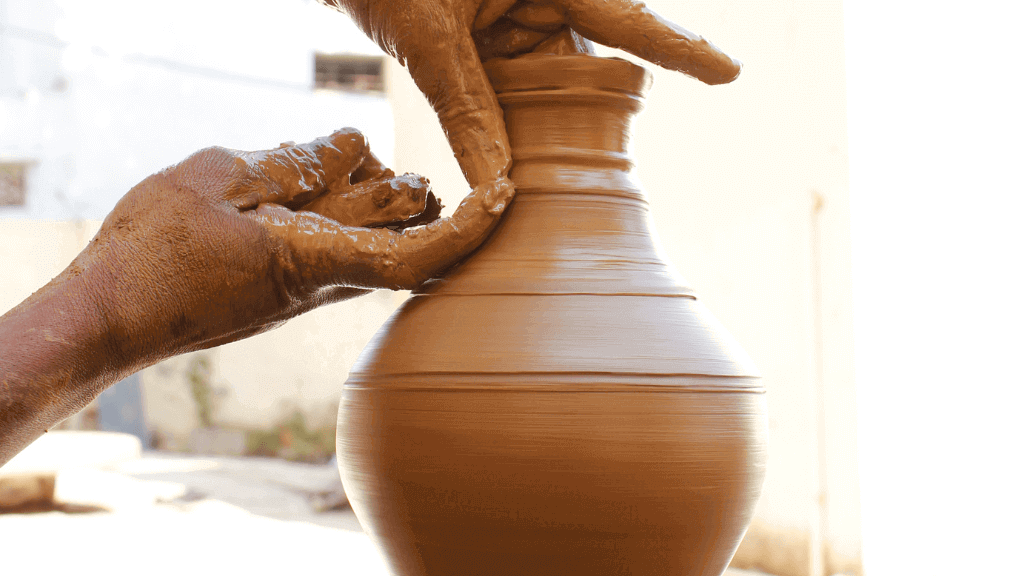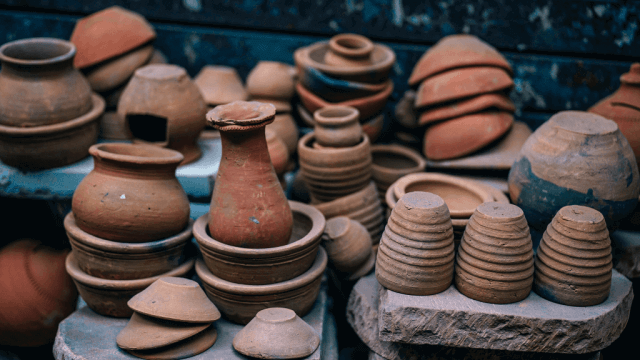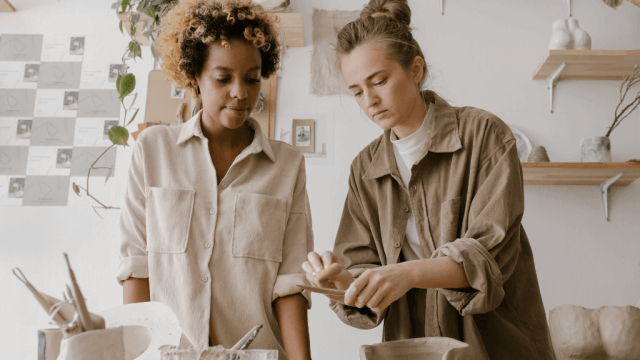Pottery kilns typically reach temperatures between 1,800°F and 2,400°F. The maximum temperature depends on the model and type of kiln. When firing at 2345°F (1285°C), Cone 10, the surface temperature of the kiln can be above 500°F (260°C).
How Hot Does A Pottery Kiln Get? How Hot Does A Kiln Get?
Understanding the temperature range of a pottery kiln is vital for both new and advanced potters. The heat within a kiln transforms the raw clay into a durable, finished product. Here’s a breakdown to guide you through the different firing ranges and their associated characteristics.
Types of Firing Ranges:
-
Low-Fire (Earthenware)
- Temperature Range: 1,650°F to 1,950°F (900°C to 1,100°C)
- Cone Range: 015 to 04
- Characteristics: This range is suitable for earthenware clays, producing porous pottery that often requires glaze to be waterproof. The clay retains rich, warm colors.
-
Mid-Fire (Stoneware)
- Temperature Range: 2,010°F to 2,232°F (1,100°C to 1,220°C)
- Cone Range: 5 to 7
- Characteristics: Stoneware is vitrified and durable, often used for everyday pottery like dishes and mugs. Glazes meld smoothly with the clay body at these temperatures.
-
High-Fire (Stoneware and Porcelain)
- Temperature Range (Stoneware): 2,280°F to 2,400°F (1,250°C to 1,315°C)
- Temperature Range (Porcelain): 2,400°F to 2,552°F (1,315°C to 1,400°C)
- Cone Range (Both): 8 to 14
- Characteristics: Produces a very durable and strong pottery. While stoneware clays remain somewhat porous, porcelain becomes non-porous and translucent.
Factors Influencing Kiln Temperature:
-
Kiln Design: A kiln’s design, whether an updraft or downdraft, can influence temperature consistency and distribution.
-
Fuel Source: Gas, wood, electric, or alternative fuels can affect both the internal temperature and the atmosphere of the kiln.
-
Loading: How the pottery is placed within the kiln can influence air circulation and heat distribution.
Tips for Monitoring Kiln Temperature:
-
Use Pyrometric Cones: These are designed to melt at specific temperatures, visually indicating the heatwork achieved in the kiln.
-
Invest in a Kiln Sitter: This device uses pyrometric cones to automatically shut off the kiln once the desired temperature is reached.
-
Digital Controllers: Modern electric kilns often have digital controllers that precisely control the firing curve.
The temperature to which a pottery kiln is heated largely depends on the type of clay being used and the desired finished product. Whether you’re a novice or a seasoned potter, understanding the intricacies of kiln temperatures can significantly impact the quality and outcome of your creations.
Understanding kiln temperatures is just one part of the pottery journey. Here are some additional insights and pro tips to help potters achieve the best results:
Kiln Atmosphere:
- Oxidation vs. Reduction Firing:
- Oxidation firing means there’s enough oxygen in the kiln for fuel and the pottery, resulting in brighter and glossier finishes.
- Reduction firing restricts oxygen, which can dramatically change glazes’ appearance, often producing richer and more varied colors.
Glazing Tips:
-
Test Tiles: Always test new glazes on test tiles before applying them to your pottery. This can save you from potential disappointments and help in predicting the outcome.
-
Glaze Combinations: Layering different glazes can produce unique and unexpected colors and patterns. However, be aware that some combinations might run off the pottery, so always leave a safe space at the bottom.
-
Glaze Thickness: The thickness of the glaze application can significantly impact the result. Too thin might leave the surface under-glazed, while too thick can lead to crawling or cracking.
Safety First:
-
Ventilation: Ensure good ventilation in the kiln area. Combustion can release harmful gases, especially if you’re working with specific materials like lusters.
-
Protective Gear: Use heat-resistant gloves and safety goggles when loading and unloading the kiln.
Maintenance and Longevity:
-
Kiln Wash: Apply kiln wash to your kiln shelves to protect them from dripping glazes. This prolongs the life of your shelves and ensures smoother firings.
-
Regular Inspection: Regularly check the kiln’s elements, bricks, and wiring for wear and tear. Maintaining your kiln can extend its life and ensure consistent firing results.
Pro Tips:
-
Slow Cooling: Some glazes benefit from slow cooling which can enhance crystal growth in the glaze, producing more depth and variability.
-
Note Keeping: Keep detailed notes of each firing, including temperature, hold times, and glaze combinations. This will make replicating successful results (or avoiding past mistakes) much easier.
-
Join a Community: Join pottery forums or local pottery groups. Sharing experiences and asking questions can provide invaluable insights, especially when troubleshooting.
In the world of pottery, there’s always more to learn. Continuous experimentation, combined with the rich history and ceramics tradition, offers endless possibilities for growth and creativity.
Kiln Temperature Ranges
| Kiln Color | Cone | °F | °C | Description |
|---|---|---|---|---|
| White | 14 | 2552° | 1400° | Porcelain: Ranges from cone 10-13 |
| Yellow | 10 | 2380° | 1300° | High-fire/Stoneware: Typically found within the cone 8-10 range, with an average around cone 10 |
| 6 | 2192° | 1200° | Mid-range glaze: This temperature covers cones 2-7 | |
| 04 | 1950° | 1100° | Low-fire/Earthenware: Ranges from cone 015-1, with an average at cone 04 | |
| Yellow-Orange | 1000° | Transition phase: Between low-fire and mid-range temperatures | ||
| 010 | 1650° | 900° | Clay particles start to vitrify; This is the lowest recommended BISQUE temperature, covering cones 010-04 | |
| 1450° | 800° | Vitrification starts. Carbonaceous material is being burned off from the clay body. | ||
| Red | 018 | 1292° | 700° | RED HEAT: Clay achieves a solid red hue |
| Dull Red | 600° | Transition phase: Between the red heat and the later stages of heating | ||
| 1060° | 500° | At 573° C, quartz undergoes inversion during both heating and cooling stages | ||
| 400° | Between 480-700° C, chemical water (often referred to as “water smoking”) is released from the clay | |||
| 300° | From 300-800° C, carbonaceous material (organic compounds) burn off from the clay | |||
| Dark | 439° | 200° | At 220° C, cristobalite (a form of silica) undergoes expansion when heating and contraction when cooling. | |
| 212° | 100° | Water within the clay starts converting to steam and expands. This can result in potential clay breakage if not dry. |
This table provides a comprehensive understanding of the heatwork in pottery. Each phase of heating has its characteristics, and understanding these can be crucial for achieving desired results in pottery.
Low-fire Kilns: A Gentle Introduction to Pottery Firing
Clay Body Type
Low-fire clays, including earthenware, are ideal for beginners due to their forgiving nature during firing.
Temperature Range
Typically, these kilns operate between 1675°F to 2100°F (913°C to 1150°C).
Cone Range
Low-fire usually sits in the 018 to 04 cone range.
Kiln Color
Inside, the kiln will exhibit a soft orange glow.
Firing Results
The pottery pieces emerge with a porous texture, which is why it’s essential to glaze them to make them waterproof.
Low-fire Glazes
These glazes mature at low temperatures and can offer a bright, vibrant color palette.
Kiln Options
Electric kilns are the most common type used for low-fire, as they’re convenient and easy to control.
Mid-range Kilns: Striking the Balance
Clay Body Type
Stoneware is the typical clay used in mid-range firing.
Temperature Range
Mid-range kilns operate between 2100°F to 2262°F (1150°C to 1240°C).
Cone Range
The cone range for mid-range is generally 4 to 6.
Kiln Color
Expect a bright orange glow inside.
Firing Results
The pottery has a sturdier finish compared to low-fire, making it perfect for everyday use.
Mid-range Glazes
These glazes have a diverse palette, often resulting in rich and warm tones.
Kiln Options
While electric kilns are popular, gas kilns are also used, particularly for achieving reduction atmospheres.
High-fire Stoneware Kilns: Taking Pottery to Its Peak
Clay Body Type
High-fire stoneware is exceptionally durable, perfect for pottery that will see heavy use.
Temperature Range
The kilns operate between 2300°F to 2381°F (1260°C to 1305°C).
Cone Range
Typically, it sits in the cone 8 to 10 range.
Kiln Color
Inside, you’ll witness a vibrant yellow-white heat.
Firing Results
The final products are dense, robust, and non-porous, even without glazing.
High-fire Glazes
These glazes can handle the intense heat and provide a glossy, smooth finish.
Kiln Options
Gas kilns dominate this range due to their ability to achieve both oxidation and reduction atmospheres.
High-fire Porcelain Kilns: The Pinnacle of Elegance
Clay Body Type
Porcelain, known for its fine texture and pure white color, is the star here.
Temperature Range
Similar to stoneware, it operates between 2300°F to 2381°F (1260°C to 1305°C).
Cone Range
Again, it’s generally in the cone 8 to 10 range.
Kiln Color
Like stoneware, the inside glow is a luminous yellow-white.
Firing Results
Pieces emerge with a translucent, glassy finish — the hallmark of high-quality porcelain.
Porcelain Glazes
Specialized glazes for porcelain accentuate its smooth texture and enhance its translucence.
In conclusion, the temperature a pottery kiln reaches plays a vital role in determining the final outcome of the ceramic piece. Whether you’re just starting with low-fire clays or mastering the art of porcelain, understanding the kiln’s heat is fundamental to your pottery journey.
What materials are commonly used to make pottery kilns and how do they impact the maximum temperature the kiln can reach?
Pottery kilns are typically made of firebricks, which are able to withstand high temperatures. The maximum temperature a kiln can reach is determined by the type of fuel used and the materials used to construct it. For example, electric kilns can reach up to 2350°F (Cone 10) while gas-fired kilns can reach up to 1500°C (2732°F). A pottery kiln should not be opened until it has cooled to 125°F (51°C).
Can the temperature inside a pottery kiln be controlled and adjusted during the firing process? If so, how is this achieved?
Yes, the temperature inside a pottery kiln can be controlled and adjusted during the firing process. This is achieved by using an electronic controller to turn up the kiln and turn off the kiln, as well as to do a controlled cool down. Additionally, thermocouple offset can be subtracted to raise the temperature in the kiln. Temperature or heatwork can also be measured during and after firing using several methods.
Are there any safety concerns that need to be taken into consideration when operating a pottery kiln at high temperatures?
When operating a pottery kiln at high temperatures, there are several safety concerns that need to be taken into consideration. Hot kilns produce infrared radiation which can be hazardous to the eyes and should be protected against with safety glasses, infrared goggles or a handheld welding shield. Toxic volatiles may also be released during firing and should be properly ventilated. Additionally, the heat build up in an enclosed room could present a significant fire hazard. Finally, pottery kilns should not be opened until they have cooled to at least 125° F (51° C) to avoid injury and damage.
How long does it typically take for a pottery kiln to reach its maximum temperature and how long does it need to maintain this temperature for the firing process to be successful?
It typically takes 3-6 hours for a pottery kiln to reach its maximum temperature. The firing process needs to maintain this temperature for 7.5 hours or longer , depending on the clay body and firing schedule.
What are some common signs or indications that a pottery kiln has reached its maximum temperature?
Common signs that a pottery kiln has reached its maximum temperature include the guard cone remaining standing , the kiln surface becoming extremely hot (up to 500°F/260°C) , and the kiln being unable to rise in temperature at a rate of at least 12°F (6.7°C) per hour.











